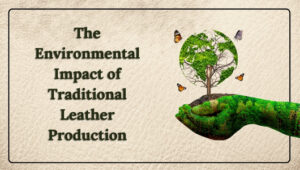Sustainable Leather: Eco-Friendly Practices and Innovations
Understanding Sustainable Animal Leather
 Animal leather has been cherished for centuries for its durability, timeless appeal, and versatility. However, traditional leather production has faced criticism due to its environmental impact. From resource-intensive processes to the use of harsh chemicals, there are significant challenges that need addressing.
Animal leather has been cherished for centuries for its durability, timeless appeal, and versatility. However, traditional leather production has faced criticism due to its environmental impact. From resource-intensive processes to the use of harsh chemicals, there are significant challenges that need addressing.
Yet, sustainable practices in animal leather production are emerging, focusing on reducing environmental harm while preserving the unique qualities of leather. By adopting eco-friendly methods and innovations, the leather industry is evolving to meet the growing demand for more sustainable products. Let’s explore how the industry is making leather production greener, while still celebrating the rich qualities of animal leather.
The Environmental Impact of Traditional Leather Production
Traditional leather production can have a considerable environmental footprint. Processes like tanning often require large quantities of water and chemicals, such as chromium, which can harm ecosystems if not managed properly. Additionally, livestock farming for leather contributes to deforestation and greenhouse gas emissions.
Key Issues in Leather Tanning and Dyeing
One of the main concerns is the use of chemical-intensive tanning and dyeing processes. Chromium tanning, widely used for its speed and efficiency, can release harmful waste that contaminates water bodies and soil. Similarly, synthetic dyes often contain heavy metals, which can impact both the environment and human health.
 Eco-Friendly Leather Practices Making a Difference
Eco-Friendly Leather Practices Making a Difference
To mitigate these environmental impacts, many leather producers are turning to sustainable practices that reduce the use of harmful chemicals, conserve water, and lower carbon emissions. For example, vegetable tanning utilizes natural tannins from tree bark, leaves, and fruits, offering a more environmentally friendly alternative to chrome tanning.
Additionally, closed-loop water systems and renewable energy sources are being integrated into production facilities to minimize waste. These practices help create high-quality animal leather with a reduced environmental footprint, meeting consumer demand for eco-conscious products.
 Vegetable Tanning: A Greener Choice for Animal Leather
Vegetable Tanning: A Greener Choice for Animal Leather
Vegetable tanning is an age-old method that aligns well with modern sustainability goals. Using plant-based tannins from sources like oak or chestnut trees, this process avoids harsh chemicals and results in leather that is both durable and biodegradable. Vegetable-tanned leather develops a rich patina over time, enhancing its unique character and appeal.
While the process takes longer than conventional methods, the result is a high-quality leather that maintains its natural properties and minimizes environmental impact.
Reducing Water and Energy Usage in Leather Production
Sustainable animal leather production also focuses on reducing water and energy consumption. Many tanneries are adopting water recycling systems and using renewable energy sources, such as solar or wind power, to run their operations. By investing in energy-efficient equipment and cleaner production technologies, the leather industry is taking significant steps toward sustainability without compromising on quality.
Innovative Approaches to Sustainable Leather Production
Innovation is key to achieving sustainability in animal leather production. New technologies are being used to optimize waste management, improve energy efficiency, and reduce the environmental impact of tanning and finishing processes. Biodegradable treatments and coatings are also being developed to replace traditional chemicals.
These advancements not only reduce the carbon footprint but also maintain the inherent qualities of animal leather, ensuring that it remains a preferred choice for high-quality, long-lasting products.
Technological Advances Driving Sustainability
Cutting-edge technologies are transforming how leather is produced, making it more sustainable. Digital tools for better resource management, AI-driven systems to enhance production efficiency, and new biodegradable chemicals for tanning are just some examples of how the industry is innovating.
By incorporating these technologies, leather manufacturers can minimize waste, reduce emissions, and create leather products that are both beautiful and responsibly made.
The Future of Sustainable Leather: Trends to Watch
As the demand for sustainable products grows, the future of leather production is shifting toward greener practices. Brands are increasingly transparent about their sourcing and production methods, allowing consumers to make informed choices. Circular economy models, where waste is minimized, and materials are reused, are becoming more prevalent.
Collaboration between leather manufacturers and tech companies is leading to exciting developments in traceability and sustainable practices, ensuring every step in the leather supply chain is accountable and eco-friendly.
Conclusion:
Moving Forward with Eco-Friendly Animal Leather Choices
Sustainable animal leather is about balancing tradition with innovation. By embracing eco-friendly practices and new technologies, the leather industry can significantly reduce its environmental impact while maintaining the integrity and quality of its products.
For consumers, choosing sustainable animal leather products means supporting responsible production practices that respect the planet and the craft of leather-making. This approach offers a way to enjoy the timeless elegance and durability of leather, knowing it has been produced with care for the environment.






